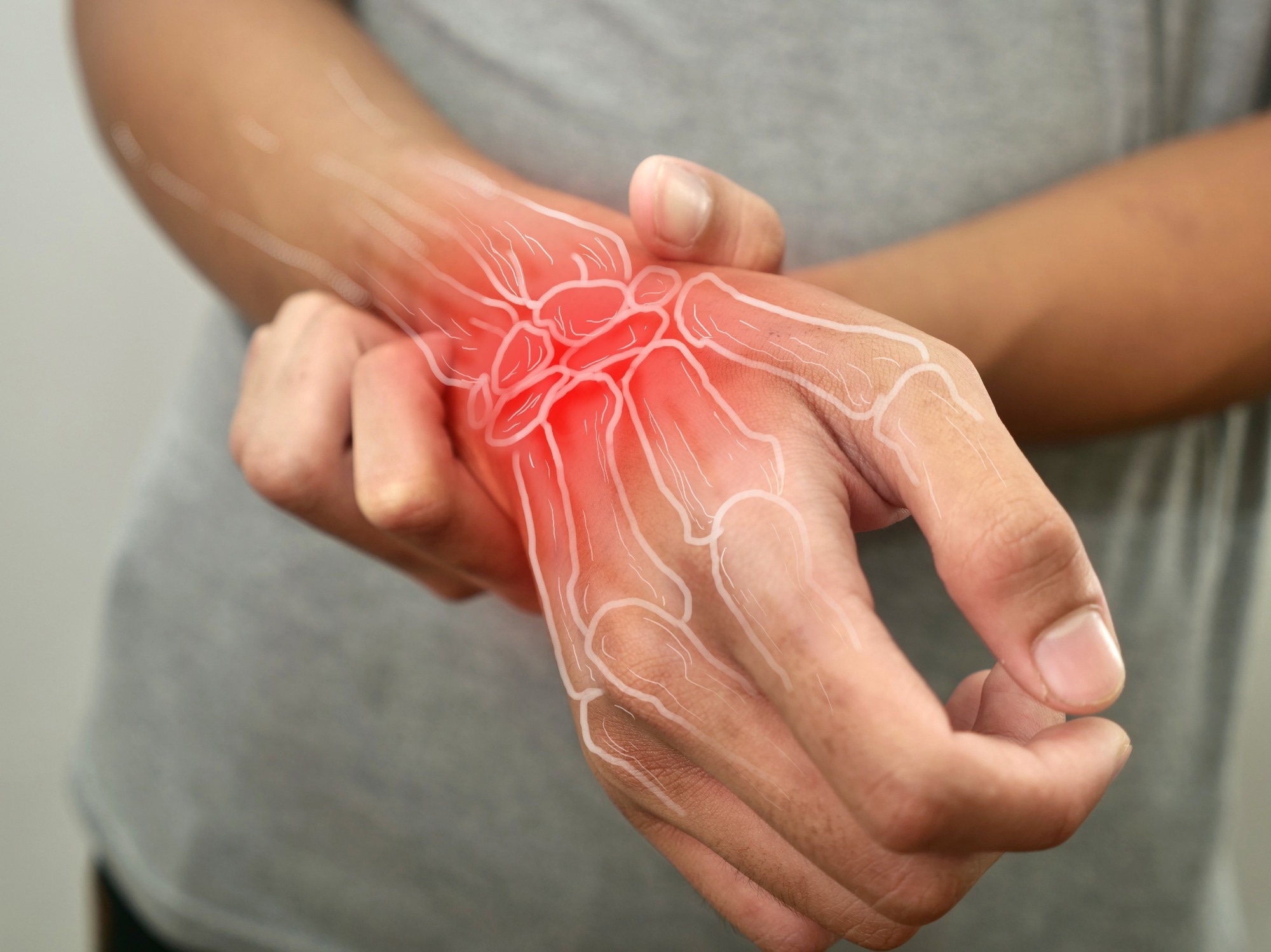In a recent study published in Nature Communications, researchers report that osteoarthritis (OA) is caused by the loss of Gremlin 1 (Grem1)-lineage chondrogenic progenitor (CP) cells.
 Study: Loss of Grem1-lineage chondrogenic progenitor cells causes osteoarthritis. Image Credit: airdone / Shutterstock.com
Study: Loss of Grem1-lineage chondrogenic progenitor cells causes osteoarthritis. Image Credit: airdone / Shutterstock.com
What is OA?
OA affects all tissues in the joint, which subsequently leads to joint pain, instability, and disability. There is no cure for OA, and treatments involve lifestyle changes and pain management.
OA often occurs due to injury, aging, or chronic mechanical stress. The loss of articular cartilage (AC), which has a limited capacity to regenerate, is a characteristic of OA.
Previous studies have reported that skeletal stem cells (SSCs) produce stroma, bone, and cartilage but not fat lineages. The bone-fat progenitor population was independently identified in the bone marrow.
The bone-fat and bone-stromal-cartilage progenitors in the marrow and growth plate (GP), respectively, express Leptin receptor (Lepr) and Grem1 markers. In one study, tissue-resident SSCs could be activated to generate AC; however, their location was unknown, and the stimuli only generated cartilage but not subchondral bone.
Study findings
In the present study, researchers used two mouse models of induced OA, including collagenase VII-induced OA (CIOA) and surgical destabilization of medial meniscus (DMM). These mouse models were used to examine Grem1-lineage cells, Lepr mesenchymal stem cells, and aggrecan (Acan)-marked articular chondrocytes in OA.
Rosa-TdTomato reporter mice were crossed with Lepr-cre, Grem1-creERT, and Acan-creERT mice to produce Lepr-TdT, Grem1-TdT, and Acan-TdT mice, respectively. Mice were administered tamoxifen, and surgical DMM was performed after two weeks. This caused a significant reduction in proliferating cells in non-calcified and superficial zones of the AC, thus confirming OA pathology.
Only the Grem1-lineage population was significantly reduced at the site of proteoglycan loss. The OA pathology was more severe in the CIOA model. Likewise, a significant loss of Grem1-lineage CP cells was observed in Grem1-TdT mice with reduced AC thickness.
The researchers then investigated whether Grem1 CP cells were the resident stem progenitor cells for normal postnatal AC development and maintenance. To this end, Grem1 CP cells were immediately observed in the meniscus and cartilaginous epiphysis after one week, giving rise to around 40% of the AC. In later developmental stages, Grem1-lineage CP cells generated robust osteoblasts in the subchondral bone, populating the entire joint by one month.
Lepr-lineage cells were not detected in the AC. A significant reduction in Grem1-lineage articular CP cells was observed with aging. The reduced regenerative capacity of AC was partly due to the reduction in Grem1-lineage articular CP cells and chondrocyte proliferation.
A knock-in mouse model (Grem1-DTR-Td) was generated, wherein Grem1-expressing cells concomitantly expressed the diphtheria toxin (DT) receptor (DTR) and TdTomato reporter, which made the cells susceptible to DT ablation. These mice were intraarticularly administered two doses of DT, which significantly reduced Grem1 CP cells in the AC, elevated articular chondrocytes, and induced pathological changes of OA. The data indicated that CP cells expressing Grem1 were normal progenitor cells lost during aging and their depletion resulted in OA.
Gene expression was analyzed using single-cell ribonucleic acid sequencing (scRNA-seq) data. Fork-head box protein-o 1 (Foxo1) expression correlated with Grem1 expression in articular CP cells and was significantly higher in Grem1-lineage cells in the AC than in the GP. Most cells expressing FOXO1 in the adult AC were of the Grem1 lineage, with fewer FOXO1-expressing Grem1 cells in the GP.
Conditional knock-out mice (Grem1-TdT-Foxo1) were generated and administered tamoxifen to induce the Foxo1 deletion in Grem1-lineage cells. This led to significantly fewer Grem1-lineage AC cells and increased OA pathology, thus suggesting that Foxo1 was critical to maintaining Grem1 articular CP cells and AC integrity.
When tamoxifen was administered in the early neonatal period, Grem1-TdT-Foxo1 mice exhibited a significant loss of Grem1-lineage articular CP cells, reduced AC thickness, and more severe OA pathology relative to those that received tamoxifen during early adulthood.
The researchers also examined the impact of exogenous fibroblast growth factor 18 (FGF18) on Grem1-lineage AC stem cells, given its role as an agonist of FGF receptor 3 (FGFR3) in experimental OA treatment. To this end, tamoxifen-treated adult Grem1-TdT mice received FGF18 for two weeks, which significantly elevated Grem1-lineage articular CP cells and increased AC thickness. Likewise, FGF18 treatment in OA-induced mice increased Grem1-lineage cells and AC thickness in treated joints, thereby reducing OA pathology.
Conclusions
The study findings demonstrated that Grem1-lineage CP cells contributed to neonatal articular cell formation and were critical to its maintenance in adulthood. Ablating Grem1-lineage cells in the knee joint caused OA.
FOXO1 expression was limited to superficial AC chondrocytes. Moreover, Foxo1 deletion in Grem1-lineage cells depleted FOXO1 in ACs but not in deeper chondrocyte layers, thus resulting in OA.
Thus OA can be predisposed by injury or inadequate reserves of articular cells, followed by apoptosis of CP cells and the subsequent failure of articular cartilage regeneration, underscoring OA as a cellular disease due to the loss of CP cells.
Journal reference:
- Ng, J. Q., Jafarov, T. H., Little, C. B., et al. (2023). Loss of Grem1-lineage chondrogenic progenitor cells causes osteoarthritis. Nature Communications. doi:10.1038/s41467-023-42199-1